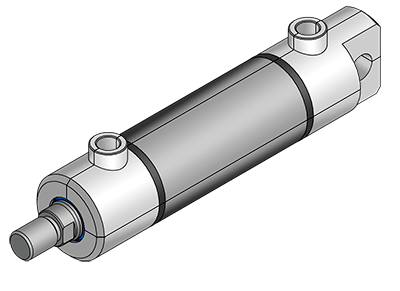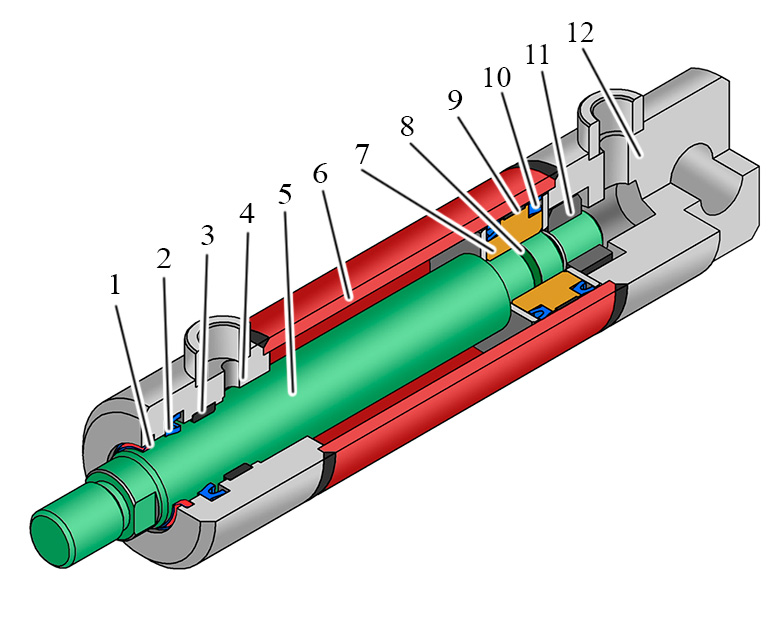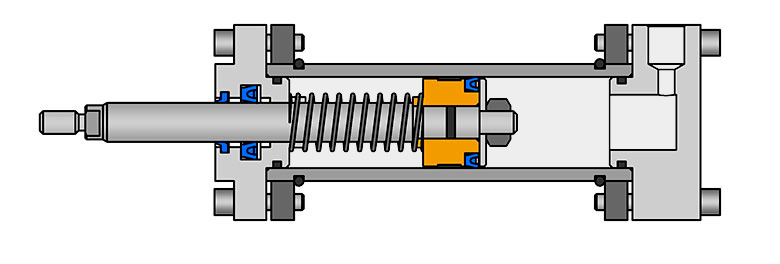Hydraulic cylinders
The hydraulic cylinder is carried out linear movements, through which forces are transferred.
Types of cylinders with respect to functions

- Single acting cylinders
- Plunger cylinders
- Cylinders with spring return
- Single acting telescoping cylinder
- Double acting cylinders
- Single rod cylinder
- Double rod cylinder
- Double acting telescoping cylinder
Double acting cylinders
Double acting cylinders have two opposing effective areas which are of the different (single rod cylinders) or same (double rod cylinders) sizes.
Single rod cylinder
Double acting cylinders with single rod have a piston rod which is connected rigidly to a piston rod which has a diameter smaller than that of the piston.
Design

A hydraulic cylinder has the following parts:
- wiper
- rod seal
- rod bearing band
- cap
- piston rod
- cylinder tube
- piston
- o ring
- piston bearing band
- piston seal
- nut
- base

Piston cavity effective area Ae = Ap. Rod cavity effective area Ae = Ap - Ar.
By feeding fluid via ports I or II, the piston may transfer pulling and pushing forces in both stroke directions.
The maximum possible cylinder force F is dependent on the maximum operating pressure p and the effective area Ae.
Hydraulic cylinder force calculator
The velocity at which the piston rod of a cylinder moves is based on the following equation:
- V - velocity rate of piston rod
- Q - flow
- Ae - effective area
Hydraulic cylinder velocity calculator.
Double rod cylinder

Double rod cylinders have a piston, which is connected rigidly to two rods which have diameters smaller than that of the piston.
The maximum possible cylinder force F is dependent on the maximum operating pressure p, the diameter of the piston, and the diameter of the rod.
Double acting telescoping cylinder

Hydraulic telescopic cylinders vary from not telescopic cylinders in that they only require a very smallamount of space to be installed into when they are retracted in comparison to not telescopic cylinders.
The piston rods siding into each other in the telescopic cylinder.
The order in which the individual stages are retracted depends on the size of they effective area.
Single acting cylinders
Single acting cylinders can only exert force in one direction.
Plunger cylinder

In plunge cylinders only pushing forces may be trnsferred.
This cylinders are used wherever a definite direction of externak force will definitely return the piston to its starting position.
Cylinder with spring return

Cylinders with spring returns are used in applications where an external, restoring force does not exist.
The rod is extended by means of pressuring the piston area with operating pressure via pipe port. The return of the piston rod is achieved by means of the spring.
Single acting telescoping cylinder

If the pistons are placed under pressure, they extend one after another.
At constatnt flow and operating pressure the extensionbegins with the largest force and smallest velocity and finishes with the smallest force and highest velocuty.